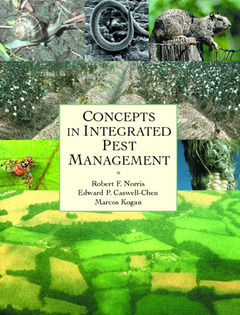Description
Concepts in integrated pest management
Authors: NORRIS Robert, CASWELL-CHEN Edward, KOGAN Marcos
Language: English
Subject for Concepts in integrated pest management:
Approximative price 101.54 €
Subject to availability at the publisher.
Add to cart586 p. · 20.5x26 cm · Hardback
Description
/li>Contents
/li>Comment
/li>
For courses in Pest Management.
This first edition text presents the basic principles of integrated pest management as they apply to plant pathogens, weeds, nematodes, mollusks, arthropods, and vertebrates. It reinforces the wisdom and soundness of the Integrated Pest Management (IPM) approach to crop protection, which attempts to limit the deleterious effects of pests in ways that are environmentally, economically, and socially acceptable. A glossary and supplemental readings are offered to expand on the explanations and definitions provided in the book, which is illustrated with numerous photographs, line drawings, and graphs.
2. Pests and Their Impacts.
3. Historical Development of Pest Management.
4. Ecosystems and Pest Organisms.
5. Comparative Biology of Pests.
6. Ecology of Interactions Between Categories of Pests.
7. Ecosystem Biodiversity and IPM.
8. Pest Management Decisions.
9. Introduction to Strategies and Tactics for IPM.
10. Pest Invasions and Legislative Prevention.
11. Pesticides.
12. Resistance, Resurgence, and Replacement.
13. Biological Control.
14. Behavioral Control.
15. Physical and Mechanical Tactics.
16. Cultural Management of Pests.
17. Host-Plant Resistance and Other Genetic Manipulations of Crops and Pests.
18. IPM Programs: Development and Implementation.
19. Societal and Environmental Limitations to IPM Tactics.
20. IPM in the Future.
Sources and References.
Pest Organisms.
Glossary.
Index.
- Integration of information on all plant protection disciplines with a comparative approach. Provides students with a realistic view of the world which is not fragmented along disciplinary boundaries and shows the interdependence of all organisms in a crop ecosystem.
- Illustrated with diagrams and photographs. Visuals make the material more interesting and understandable to students.
- Case histories and practical examples. Provide support for text information, bringing that information to life in a meaningful, applied way and helps teachers select examples and expand topics for project assignments.
- Updated with the latest technologies in the field. Includes controversial topics which are useful for class discussions.
- Co-authored by a weed scientist, a nematologist/plan




